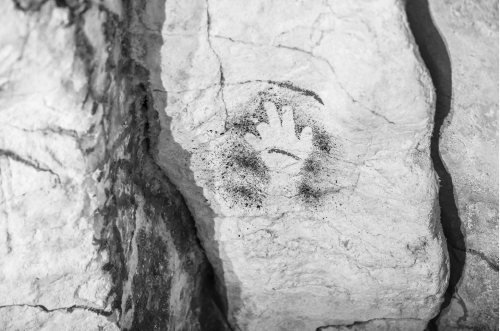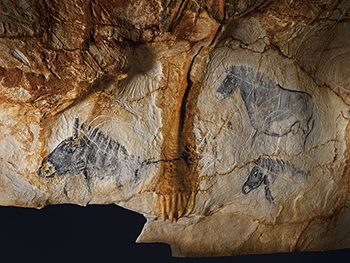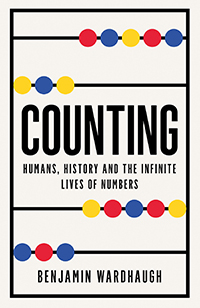
Cosquer: Counting by hand
Brief summary
This article explores stencilled depictions of human hands in the Grotte de Cosquer in France, which may represent the earliest evidence of human counting.
During the last ice age (roughly 30,000 to 10,000 years ago), a strip of land in what is now the southern fringe of Europe was occupied by humans. Although much of the continent was technically a polar desert, the inhabited area, beside the Mediterranean Sea, was not impossibly cold, with temperatures up to 12 or even 15° Celsius in the summer and relatively mild, survivable winters. Sheltered valleys had woodland with both conifers and broadleaved trees, and there was a range of land animals as well as maritime fauna: enough to support a human population. Comparable kinds of tools existed from northern Spain to the Russian plains – knives, arrows and spears – as did comparable artistic traditions. Little is certain about these people's lifestyle: it was heavily based on hunting, and they may have followed animal herds from place to place during the year.
Lifestyles were certainly shaped by the climate, and natural shelters were often used. One was a cave near the southern coast of what is now France, a few kilometres southeast of Marseilles. The entrance tunnel climbed gradually over a distance of 175 metres until it opened into a large chamber, 60 metres across and in places three times the height of a person. At the far end, there was a dome 30 metres high and a shaft nearly as deep. It was an isolated, mysterious place, and except for torchlight an utterly dark one.
No one lived there. Fires were lit to provide light, not to cook. Torches were carried in; charcoal from them fell scattered on the floor. And the walls, by the flickering light, were decorated with paintings and engravings. The earliest were made more than 27,000 years ago.
Finger-marks were made in the soft calcite that covered the walls. People went to every part of the cave, even – perhaps especially – to the most inaccessible parts of the roof, covering dozens of square metres with simple lines made by the fingers. Curves, zigzags, scrolls intersecting one another. They formed a background showing – apart from anything else – that humans had been here, had made the place their own.
Stencilled hands
Added to the walls around the same time – and involving much more effort, time and preparation than the simple schematic animals and signs – were dozens of stencilled hands. The technique was to dilute pigment – red clay or charcoal – with water, and blow it from the mouth, possibly using a tube. A hand pressed against the wall could thus make a striking stencilled image: a red or black halo with a clear, sharp image of a hand centred in it in the colour of the rock itself. If a single puff of pigment didn't work, it could be repeated, or the image retouched by dabbing on extra pigment by hand. The result was a dense ensemble of hands stencilled in various parts of the cave.
Stencilled hands are one of the iconic images from the art of the ice age, and they are known in three dozen caves across what are now Spain, France and Italy. They are familiar beyond that cultural area too, for instance in the art of Aboriginal Australia.
The French cave, now known as La Grotte Cosquer, has more than sixty hand stencils, one of the largest collections known.
The hands are distributed unevenly around the cave walls, exclusively on the eastern and northeastern sides of the cave: the right side as you go in. They are concentrated near the shaft and the vault at the eastern end of the main chamber: that is, in the more dangerous section of the cave. Many are in positions that would have required some climbing. There is a hint, perhaps, that a set of mainly red hands leads around the main chamber towards the shaft, and a large set of black ones stands beside the shaft itself, including on a stalagmite above it.
Most appear to be left hands (assuming the hand was held with the palm against the wall to stencil it). If the people were, like people today, mostly right-handed, perhaps they were using the more agile right hand to hold a torch or a supply of pigment, or to cling to a support when the position was a difficult one.
Whose hands were they? The stencilling process is a mechanical one; it records the characteristics of the maker's hand automatically, unaffected by questions of style or artistic convention. The hands bring close – in a sense, deceptively close – the individuals who made them: they are the signs of individual bodies, even of individual identities tens of thousands of years ago. They feel almost like signatures. The makers were adults: there are no child hand stencils at Cosquer. Some were over two metres tall, unless they stood on each other's shoulders or built scaffolding in the cave to reach the higher spots on the walls.
The hands stencilled were generally large and robust, though some of those by the shaft show a slimmer wrist; finger ratios and lengths are often – not always – consistent with those of modern women. There are what appear to be pairs of stencils from the same hand: one with an unusually long forefinger; another with a thicker ring finger. But just three of the stencils have been directly dated by archaeologists so far, and it is impossible to say how many people's hands are represented at Cosquer, or what period of time was involved. Is the stencil scheme the work of a single day? Of a lifetime? Or a record of visits to the cave by many people over hundreds of years, as mysterious to each other as they are to visitors today?
Gestured counting
And the evidence for counting? Some of the stencilled hands are incomplete. That is, certain of their fingers are shortened. Of the fully legible hand stencils at Cosquer, rather more than half, in fact, show less than a complete hand. These incomplete hands are, for some reason, much more common among the red stencils than the black. Incomplete hand stencils are known from a few other caves in France and Spain, but most of those known to exist are at Cosquer.

How do you produce a stencil of part of a hand? Suggested explanations have included that the hands in question were really incomplete: that these hunter-gatherers suffered from frostbite, from disease, or practised ritual mutilation. But their sheer number – and the impracticality of living a Palaeolithic life with a mutilated hand – count against these possibilities, and the balance of opinion seems to be that the simpler explanation is right: that the incomplete stencils were made by folding down certain fingers. Modern experiments have confirmed that it is possible to make stencils like those at Cosquer by folding down one or more fingers and pressing your hand against a rock surface. The bent fingers prevent the hand from quite touching the rock, resulting in a characteristically slightly fuzzy outline at those points: a characteristic that can be seen in the stencils at Cosquer.
Given four fingers and a thumb, there are in all thirty-two possibilities for folding down some, none or all of them. At Cosquer just five of those possibilities were used, namely those patterns in which the extended digits are thumb alone; thumb plus index finger; thumb, index and middle; thumb, index, middle and ring; and all five fingers. It is impossible that this was a matter of chance. Moreover, one of the patterns – folding down just the little finger – is relatively hard to make. This set of five hand shapes was deliberately chosen by the stencil makers at Cosquer
Why? As with other prehistoric signs and proto-signs, the more general question of the meaning of Palaeolithic hand stencils has been a vexed one for over a century; one scholar aptly says that here modern observers are "uninvited guests in a system of communication designed for others" But, for the set of hand stencils at Cosquer, it does seem possible to go further: to say that the five hand positions that were used meant something, and that the twenty-seven others were left out because in this system they had no meaning. And it is almost impossible to avoid the speculation that the hand positions recorded had something to do with counting. They form a sequence consisting of extending the digits one after another; they are one of the easiest ways you can count to five on your fingers. They are a good candidate for the earliest counting vocabulary recorded: a vocabulary not of spoken words but of gestures; a sign language.
Game or ritual?
Other caves with hand stencils display different vocabularies, using finger combinations that are not seen at Cosquer. Many locations show complete hands only, or record a more restricted set of folded-finger gestures. Perhaps the language of hand gestures differed from place to place; perhaps chance survival of fragile images in difficult environments has played a role. That does not detract from the consistency and suggestiveness – to say no more – of the evidence at Cosquer.
The gestured numbers, if that is what they are, do not all appear with the same frequency. The complete hand is by far the most common gesture recorded; those showing smaller numbers of fingers are progressively less common, with the interesting exception that four fingers is less common than three. A sign for zero (logically, you would fold down all five fingers and stencil just your fist) does not appear at all. The signs never seem to appear in relationship to each other – sequences of numbers, pairs – nor do they occur in two-handed groups that might suggest counting to numbers beyond five. If this was a number vocabulary, in other words, it ran only from one to five.
As with other prehistoric counts, it is impossible to be sure what was being counted. But the proximity of images of animals, including animals with signs on them such as barbs that might be schematised weapons, means that a strong possibility is a count of animals taken. Another would be a count of visits to the cave.

Nor is it certain why people chose to record these gestures by stencilling in this particular location. To turn a gesture into a stencil is to extend it beyond your body and – potentially – beyond your own lifetime, to transmit it to people you have not met and to generations not yet born. Yet to place the stencil on the wall of a deep cave requires those who wish to see it to visit that location. Like certain tallies, these counts were not portable, could play no part in exchange with other groups in other locations. Their position in a dark cave at the end of a long tunnel hints at a special purpose, but anything from a game or a joke to an important ritual is equally possible.
A cavernous palimpsest
It is not clear how long this use of Cosquer went on: years, centuries, or even longer. But eventually it ended and the cave, it seems, was neglected for millennia. It was then used again, around 19,000 years ago. The walls began to become a palimpsest, made by people who knew nothing of each other beyond what was recorded on the walls of the cave. This later period saw some of the hand stencils destroyed, scratched or overwritten with new signs, changing their meaning in ways that are just as impossible to recover as is the original significance of the cave and its decorations. A wealth of paintings in black were added at this stage: over 150 images of horses, bison, deer as well as seals and – not yet extinct – great auk.
The cave was abandoned once again, and as the ice began to retreat 16,000 years ago, the sea rose towards its entrance. Some time around 5000 BCE the cave mouth was closed by water, along with those of many other caves along the coast of what is now France, in the area of Marseilles and Cassis. Others, surely, had been used by prehistoric people. By about 500 CE, the sea had reached something like its present level, with the cave mouth more than 30 metres below the surface. Sea water destroyed perhaps three-quarters of the paintings, stencils and engravings, and the cave remained unknown until its rediscovery by a professional diver in the 1980s. Its art has been documented since 1991; it is the only painted cave known today whose present entrance is under sea level. It is also the only location with evidence of prehistoric counting in this particular form: an astonishingly lucky survival. Without it, the finger-counting of the Stone Age would be gone for ever.
About his article
 This article is an extract from the book Counting: Humans, history and the infinite lives of numbers by Benjamin Wardhaugh (William Collins). The book explores what it means to count, how we developed this incredible skill and what impact it has had on our societies.
This article is an extract from the book Counting: Humans, history and the infinite lives of numbers by Benjamin Wardhaugh (William Collins). The book explores what it means to count, how we developed this incredible skill and what impact it has had on our societies.
Benjamin Wardhaugh is a historian and author, based in Oxford, UK. He holds degrees in mathematics, music and history, and was a fellow of All Souls College for twelve years. He researches and writes about mathematics in the past, and is the author of Gunpowder and Geometry and Encounters with Euclid.
